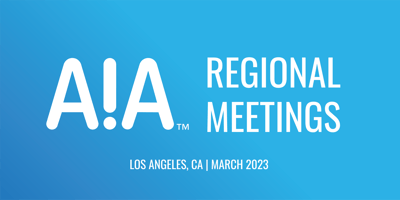Leading by Actively Listening
Since becoming CEO in early 2020, one of my top priorities has been listening. It was essential to understanding and addressing the impact of the pandemic on AIA, and it has been vital to thoughtful decision-making and organizational alignment during the past three years as we’ve transformed our organization. I am deliberate about asking for—and then truly listening to—input from our Owner Community and our employees, and this focus on listening has made us stronger and more collaborative.
While listening sounds simple, doing it well requires practice. By approaching conversations with an intentional focus on listening rather than responding, you can get better at active listening. Active listening is a critical communication skill that allows you to demonstrate — through relevant questions and body language—that you hear what someone is saying. It also helps you improve your ability to retain important information—and make the person who’s speaking feel valued.
I regularly practice three key steps that make me a better listener—and leader:
1. Keep an open mind.
This isn’t always easy because, as human beings, we all have individual biases and preconceptions. But I practice being open, neutral, and nonjudgmental every time I engage. I find that when I successfully withhold judgment and refrain from making assumptions, I walk away from the interaction with a sense of accomplishment and a fresh way of thinking about something.
2. Bring my natural curiosity into the conversation.
The Emotional Intelligence Network’s blog underscores this idea: “Curiosity is an invaluable partner to listening. There’s a Japanese proverb that says, ‘The other side also has another side.’ Everyone has a story. There’s something fascinating hiding just out of view. Curiosity opens you up to really listen.” I love that proverb and think about it when I’m listening to others. There is always something I can learn from a conversation with an employee, supplier, or owner that will make our AIA Community better. But discovering those valuable nuggets requires my curiosity, questions, and engagement.
3. Listen to what is being said – and what is not said.
As Peter Drucker said, “The most important thing in communication is to hear what isn’t being said.” As a natural extension of my curiosity, I look into the eyes of the person I am listening to and watch their body language. If I sense nervousness or uncertainty, I ask questions that I hope will encourage the other person to open up more fully. Or, with a nod of my head or a smile, I give them the confidence to go on. If I sense there is more to the story but the person isn’t ready to share it, I make sure they know that I welcome their input at any time. Sometimes that’s all it takes for the person to say what they truly wanted to say.
Active listening is a key characteristic of good leadership. For me, keeping the Japanese proverb “The other side also has another side” top of mind is a helpful pathway to active listening that creates a true openness to the ideas and input of others.
.png?width=100&height=54&name=AIA_Logo_CMYK_Primary---Blue-Green%20(1).png)



